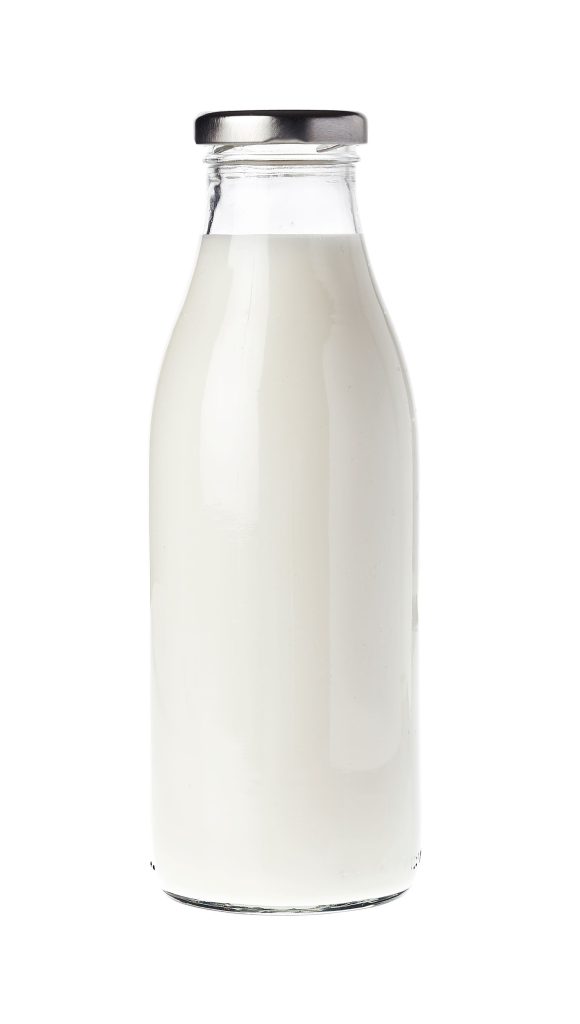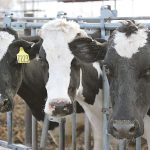Benchmark drops 68 cents

Filled milk bottle
The Agriculture Department announced the October Federal order Class III milk price at $16.91 per hundredweight, down 68 cents from September, $5.94 below October 2024, and the lowest Class III price since April 2024. That put the 10 month Class III average at $18.31, down from $18.82 a year ago, and compares to $17.10 in 2023.
The Friday, Nov. 7 Class III futures settlements had the November contract at $17.20; December, $16.98; January, $16.50; February, $16.51; and March at $16.72.
The October Class IV price is $14.30, down $1.87 from September, $6.60 below a year ago, and the lowest Class IV since March 2021. Its 10 month average stands at $18.11, down from $20.71 a year ago and compares to $18.93 in 2023.
Frustration continues in our nation’s capital and around the country as the government shutdown remained in place last week, even impacting airline flights. It was announced that food aid for the 42 million Americans dependent on the Supplemental Nutrition Assistance Program would be partially funded after two judges ruled that USDA contingency funds must be used. President Trump however stated on Truth Social that the SNAP benefits “will be given only when the Radical Left Democrats open up the government and not before.” A federal judge ordered the administration to pay full November benefits by Friday. Late word Thursday was that another Senate vote on the shutdown would be held Friday as it has reached the longest shutdown ever. It appeared Friday morning the votes needed are still not there.
The Agriculture Department did announce that it will publish a few of its regular reports, despite the shutdown. The September Milk Production report was issued Nov. 10 and the Crop Production and World Agricultural Supply and Demand Estimates were released Nov. 14. The Dairy Products report, which would have been issued last week was not.
The U.S. Supreme Court heard arguments last week regarding the legality of President Trump’s tariffs. The case was being closely watched and could have huge implications for global trade and U.S. policy. Meanwhile, trade talks with Canada have not been rescheduled since the furor over a Canadian financed TV ad campaign prompted Trump to end the talks. Canadian Prime Minister Mark Carney apologized for the campaign.
“Dairy margins were flat to weaker the last half of October as higher milk prices and an increase in the feed markets were largely offsetting,” said the latest Margin Watch from Chicago-based Commodity and Ingredient Hedging LLC.
“While the milk market was higher, this was only in Class 3 futures while ongoing weakness in butter caused Class 4 to sell off. Butter prices have reached a four-year low with the spot CME market dropping to $1.545 per pound to reach the lowest price since early 2021.”
“Increased butterfat in milk tests combined with rising global milk output has depressed butter prices both in the U.S. and other markets and U.S. producer milk checks in most federal orders,” the MW stated. “The Class 3 market caught a bid though as several U.S. cheese plants experienced production issues recently that reduced cheese production during October.”
Both Mozzarella and Cheddar barrel production was well below expected output due to unplanned disruptions for maintenance and compliance. USDA’s Dairy Market News mentioned downtime in each of its last five weekly reports during October, also noting that spot Cheddar barrel inventories were “somewhat tight.”
Rabobank’s latest dairy report took a look at consumer trends, animal protein and dairy production. It stated “Food inflation continues to outpace overall inflation, and restaurants are feeling the pressure, with nine straight quarters of declining traffic.” Speaking in the Nov. 10 Dairy Radio now broadcast, Rabobank senior dairy analyst Lucas Fuess said there continues to be signs of stress by consumers at retail as well as restaurants, though some are doing well.
Grocery store sales in key dairy products are still trending higher, according to Fuess, as dairy is an affordable form of protein, especially when compared to other protein sources. U.S. beef prices are at multi-year highs, he said, due to the U.S. herd being at the lowest level in decades, a result of higher feed costs and drought the past few years. The USDA’s all-fresh beef price reached a record $9.18 per pound in August,” according to Rabobank. “U.S. cattle slaughter from January through September was down 1.5 million head, or 7% from a year ago.”
“Pork prices also remain well ahead of year-ago levels and the five-year average, with cutout values of $109 per cwt. are averaging 15% above last year. Chicken production continues to outpace year-ago levels, and prices are down sharply in recent weeks, with boneless breast meat prices now 27% below year-ago levels.”
“Crop producers are also under pressure,” Rabobank said. “Corn stakeholders are pushing for year-round use to boost ethanol demand, while soybean surpluses are increasing reliance on proposed biodiesel mandates to absorb excess supply,” Rabobank warned.
“August milk production increased 3.2% versus the prior year, and at 9.52 million cows, the herd size is now the largest since the mid-1990s. July total dairy exports were up 7% year over year, and cheese is on track for a record year,” Rabobank concludes. We’ll get September data this week.
Fluid milk sales were down again in August. The USDA’s latest data showed packaged sales totaled 3.48 billion pounds, down 4.0% from August 2024, and follows a 1.2% dip in July. Conventional product sales totaled 3.2 billion pounds, down 3.6% from a year ago. Organic sales, at 236 million, were down 9.4%, and represented 6.8% of total milk sales in the month, down from a typical 7.2%.
Whole milk sales totaled 1.3 billion pounds, down 2.6% from a year ago, but up 0.1% year to date. Whole milk represented 36.3% of total sales for the month, down 2% from July’s percentage. Skim milk sales totaled 171 million pounds, up 7.0% from a year ago, and up 0.3% year to date.
Packaged fluid sales in the eight month period totaled 27.9 billion pounds, down 1.5% from 2024. Conventional product sales amounted to 25.9 billion, down 1.5% from a year ago. Organic products, at 1.99 billion pounds, were down 1.4%, and represented 7.1% of total milk sales in the eight months.
China Customs Statistics shows Chinese butter imports soared to 23.7 million pounds or 10.76 metric tons (MT) in September, up 23.7% from September 2024, and the first time ever to surpass 10,000MT, according to HighGround Dairy’s Cara Murphy in the Oct. 27 Dairy Radio Now broadcast. Sailings from New Zealand were up 86%, she said, and that increased its market share to 84%. Additional shipments came from Argentina, United Kingdom, and Denmark, with little from the U.S., despite U.S. prices at a huge discount to the rest of the world. U.S. shipments totaled just 24,251 pounds, down 58% from 2024.
Cheese imports totaled 31.5 million pounds, up 13.5%, with New Zealand remaining the primary origination country. China has a trade agreement with New Zealand, according to Murphy, and shipments were up 18.0% year-to-date. But, New Zealand cheese sailings were down 60MT or 0.74%, as China bought more product from Australia, Denmark and France, Murphy said. European cheese prices have fallen below the U.S. on the European Energy Exchange so this will change things in the global marketplace, she said. New Zealand remains the highest in price right now.
Whey imports, at 117.4 million pounds, were down 3.1%, following two consecutive months of growth. Murphy said shipments from the U.S. were only off 0.5%. The overall decline was primarily driven by lower sailings from Ireland, Netherlands and France. Chinese pork prices have fallen to multi-year lows, and Murphy said the government is urging hog farmers to reduce supplies, as it reduces farm subsidies. “We really want to pay attention to this market,” she concluded, “It’s a big one for whey and, as the hog population in China starts to come down, we might see those whey shipments decline as well.”
Whole milk powder imports, at 32.3 million pounds, were up 41.2%, while skim milk powder imports totaled just 18.5 million, down 12.5% from a year ago.
Checking prices, CME block Cheddar dropped 10.25 cents the first day of trading last week and lost 1.75 cents Tuesday, Nov. 4 dipping to $1.6475 per pound, lowest since Sept. 26. It closed Friday, Nov. 7 at $1.66, down 10.75 cents on the week, and 6 cents below a year ago.
The barrels were down 5.50 cents Monday, Nov. 3 and a nickel on Tuesday, falling to $1.70. That’s where they closed Friday, 10.50 cents lower on the week, lowest since Sept. 30, 6.75 cents below a year ago, and an inverted 4 cents above the blocks. Sales totaled 25 loads of block on the week and no barrel.
HighGround Dairy’s “Monday Morning Huddle” warned; “Given the heavy milk volumes and new cheese capacity, it seems unlikely that the (previous) price increases were due to supply constraints, other than the seasonal troughs in milk production in October and November. Cheese prices tend to increase in third and fourth quarter due to increased demand from the holidays and football season.”
“Prices could maintain these levels a bit longer, but the team at HighGround expects declines at the tail end of 2025 into early 2026, as demand wanes and the Northern Hemisphere flush kicks up.”
StoneX says “Fresh Cheddar was likely in good demand short term as some final holiday buying and exports were getting booked but that has since waned. Markets expected that demand to pull back and continue to be weighed down by strong milk production expectations.”
Central region cheesemakers told Dairy Market News that retail and food service sales are steady but some note lighter demand compared to a year ago. Milk production is steady, but some cheesemakers say strong demand from Class I processors was reducing spot availability. Some cheesemakers were still down for maintenance and selling spot milk to nearby processors. Demand for Class III milk was somewhat light as cheesemakers have sufficient volumes internally. Class III prices ranged from $2-under to $1.50-over Class at mid-week.
Western cheese manufacturers are receiving plenty of milk. Unplanned downtime and a few plants yet to run at full capacity contributed to the week’s situation. Cheese production is lighter to steady. Domestic demand is steady but not robust. Sellers generally convey sentiment that the approaching Thanksgiving holiday will strengthen demand for cheese the next few weeks. Spot load inventories of mozzarella remain somewhat tight. Export demand is steady for the most part, according to DMN.
Cash butter continued hemorrhaging, plunging to $1.4725 per pound Wednesday, Nov. 5 lowest CME price since Feb. 26, 2021, but it closed Friday at $1.4750, down 13.50 cents on the week and $1.1750 below a year ago. There were 22 sales on the week.
HighGround Dairy pointed out that the U.S. butter price is at a $1.30 per pound plus discount to Oceania midpoints and German butter prices, “meaning strong U.S. exports are likely to persist into 2026.”
Central milk output is steady and component levels remain strong, DMN said. Cream production is steady, but some plants were utilizing volumes internally and offering fewer loads on the spot market.
Demand is strong from cream cheese and Class II processors but lighter from butter makers. Mid-week cream multiples ranged from 1.05 to 1.27, up slightly the previous week. Churning is active in the Central region. Domestic butter demand is steady, but some reports are that sales are down from a year ago. Spot loads of 80% butterfat butter are available. Export interest in 82% is outpacing production, keeping stocks tight.
Fat components in milk output continue strong during the fall milk production season in the West, DMN said. Cream supplies are more than adequate for butter makers, despite production of holiday season commodities strengthening. Spot cream load demand varies from steady to stronger for butter producers. Butter production is strong on both 80% and 82% butterfat butter. Salted 80% butterfat loads are readily available, while unsalted 80% butter is somewhat tight. Domestic demand is steady. Many butter manufacturers note export demand is outpacing production of 82% butter, according to DMN.
Grade A nonfat dry milk slipped back to $1.13 per pound Monday, Nov. 3 however it closed Friday at $1.1450 per pound, up 1.25 cents on the week, but 24.25 cents below a year ago, on six sales for the week.
StoneX said “The market looks for further direction after a better than expected GDT for skim milk powder. Demand can typically improve this time of year and nonfat dry milk demand from U.S. cheesemakers has been a bright spot in recent months but a strong dollar and worries of weaker demand from Mexico keeps the market on edge.”
Dry whey remains the bright spot in the market, climbing a penny higher to 72 cents per pound Tuesday, Nov. 4 highest since Jan. 21. It gave the penny back Thursday and closed Friday at 71 cents, unchanged on the week, and 8 cents above a year ago on four CME sales for the week.








